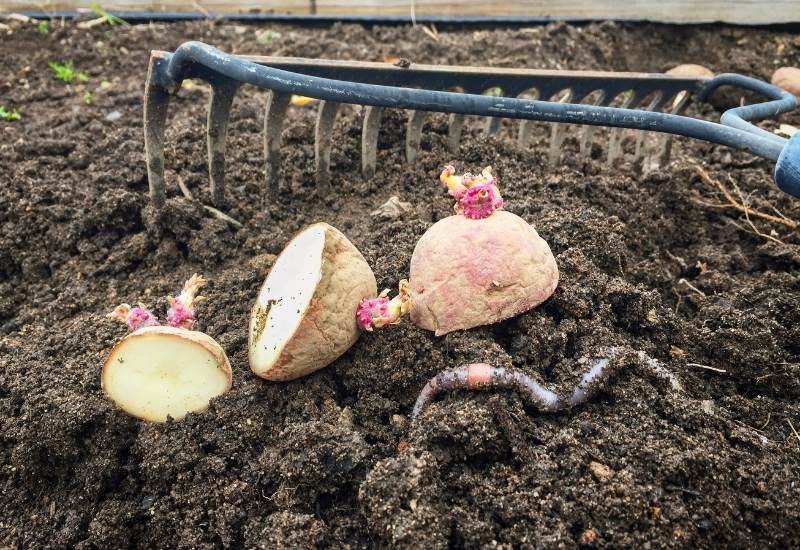
Harvesting potatoes is like digging for gold, except gold isn’t quite as fun to eat with ketchup.
So, why don’t more people add this root crop to their garden lineup?
Potatoes aren’t as popular in home gardens because they take up a lot of space and they are prone to diseases that can remain in the soil for decades. But, with proper growing techniques and careful seed selection, potatoes can be a healthy, rewarding crop.
While growing seed potatoes is easy, but there are a few things you need know about planting seed and growing potatoes to improve your shot at success.
The most important part of planting seed potatoes is choosing seed potatoes; make sure seed potatoes are certified disease-free and you will avoid most problems that come with growing potatoes. Once you have your potatoes, the planting process will depend on your available garden space.
So, let’s dig into the seed potato growing guide with instructions on what seed potatoes are, how to plant and grow seed potatoes in the ground, grow bag or containers.
What is a Seed Potato?
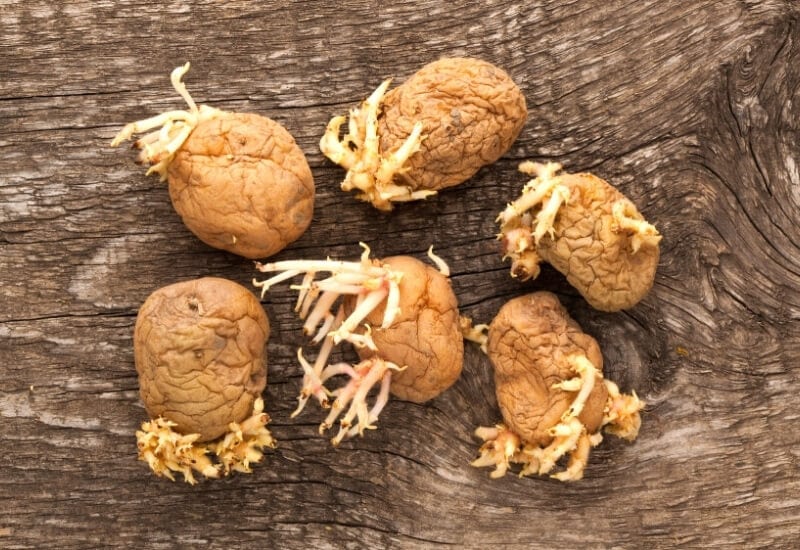
This term is somewhat confusing, because a seed potato is just a potato.
Potatoes are stems, not roots. The stem on a potato plant sends out runners, and portions of the runners swell to store energy as the leafy green top growth dies off. These swollen portions are potatoes.
Tubers are a method of asexual propagation, which means it is a method of reproduction that involves the vegetative, non-sexual, parts of a plant. The tubers overwinter in the ground, and then when the soil warms in the spring, the tubers sprout and use the stored carbohydrates to form a new plant.
Asexual propagation, also known as vegetative propagation, always produces a genetic clone. So, tubers produce exact copies of the plant they came from.
Seed potatoes are not the same as potato seeds. Potato plants will eventually flower and produce a small, green fruit with seeds inside. These are the true reproductive parts of the potato plant.
However, potatoes rarely produce viable seed, and if they do, the seedlings are small, weak, and produce very few tubers.
The major drawback to using seed potatoes is that seed potatoes are genetically identical to their parents, which means it’s impossible to cross two different potato varieties into a new hybrid. However, potato flowers function similarly to tomatoes and peppers (they’re related), so they can cross-pollinate with other varieties to increase genetic diversity.
Basically, seed potatoes are clones and potato seeds are offspring.
So, Why Does This Matter?
Because planting a seed potato is more like taking a cutting than planting a seed. When you plant a potato, the goal is to encourage the tuber to come out of dormancy and grow new roots and stems.
The key difference between a tuber and a seed is that a seed needs to take in water, known as imbibition, which then triggers the embryo to release nutrients and start developing a root system.
The process is similar, but the tuber needs much less water and should be planted deeper than a seed.
How to Choose Seed Potatoes For Planting?
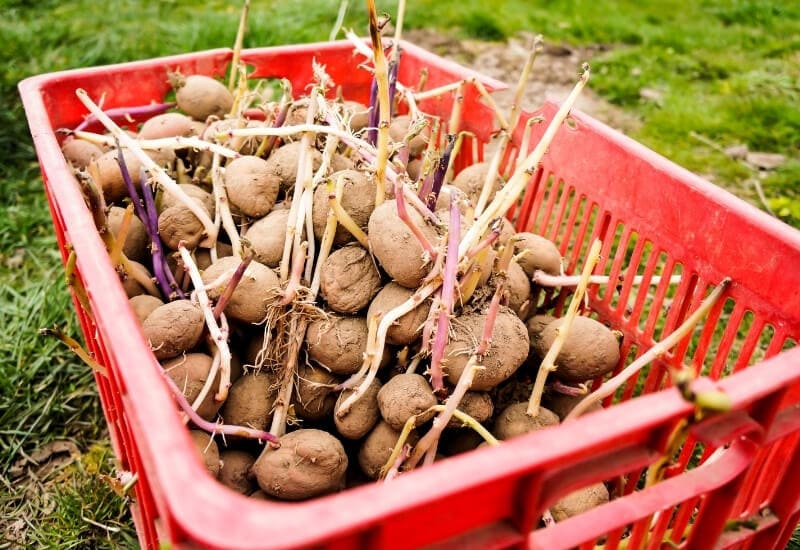
There are at least 200 potato varieties available to grow in the United States, and many are unique, colorful, flavorful tubers that aren’t available in grocery stores.
There are a few questions to answer before you buy seed potatoes:
Of course, you should never rule out the aesthetic of a potato as a tiebreaker.
What Climate Zone Do Potatoes Need?
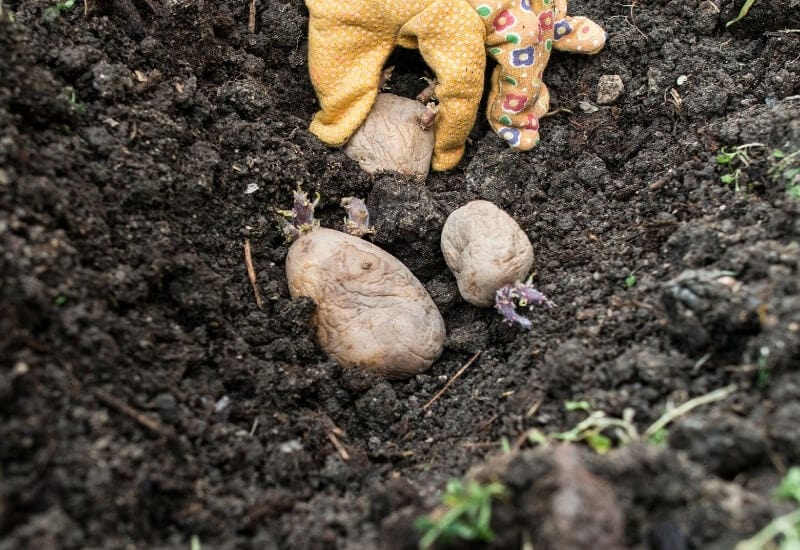
There’s a way to grow potatoes in every climate zone, but most varieties grow well in zones 6-12, which is most of the United States besides those famous for their severe winters. (We’re looking at you, Minnesota).
It’s not the winter temperatures that make it difficult to grow potatoes in the far North, it’s the shorter growing season.
Most potato varieties need 3-4 months of temperatures above 70o daytime temperatures and 50o nighttime temperatures in order to produce mature tubers. Cold climates have short seasons, so it may not be possible to grow potatoes to maturity unless you choose an early variety or decide you’re happy with smaller harvests.
You may also choose to use a structure like a hoophouse or coldframe to lengthen the growing season. Potatoes prefer cooler temperatures (under 85o), so colder climates can produce tasty tubers with a little help from a row cover to protect plants from freezing.
How Much Space Do Potatoes Need?
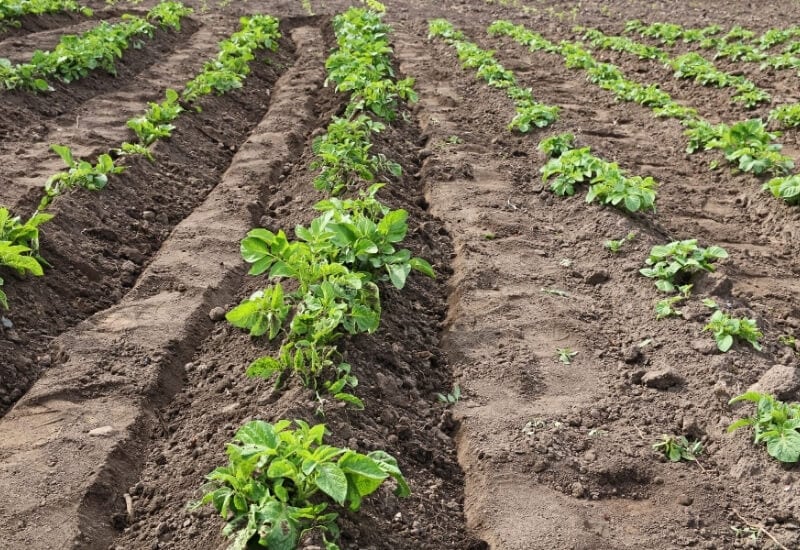
The spacing of your potato plants is flexible. In general, you should have one potato plant per square foot.
However, the spacing can change depending on when you decide to harvest.
If you only want new potatoes, space plants 6” apart. New potatoes are technically only freshly-harvested tubers, but the term has evolved to mean any small, baby version of a potato. You can also harvest new potatoes off mature plants by removing some soil and pulling up a few tubers.
Most potato varieties need 1 sq. ft of space to have enough room to develop mature tubers. However, some larger or more prolific varieties may need more space.
Other reasons you may need to adjust the spacing are:
Under average conditions, one potato plant will yield roughly 6 mature potatoes. Yields increase in loose, fertile, well-maintained garden beds.
So, how much space do you need?
Well, that depends.
How many potatoes do you want to eat?
Why Are You Growing Potatoes?
Although this seems like a silly question, it’s the most overlooked part of the gardening process.
I know a gardener who plants 40-50 tomato plants each year just because they’re easy to grow. They don’t like raw tomatoes, and they hate canning. Most years, they let the tomatoes rot on the vine.
This is a major waste of garden space.
Don’t plant a fruit or vegetable unless you have a plan for how to use the produce.
So, why do people plant potatoes?
You can plant for multiple reasons, but you have to have at least one clear purpose for why you plant anything in your vegetable garden.
If you plan on eating your potatoes, calculate how many potatoes you will use per week and multiply by 3-4 months (which is how long fresh potatoes can be stored).
For example, if you have a family of 5 and plan on using 10 potatoes per week, multiply 10 potatoes by 16 weeks for a total of 160 potatoes.
Most potato plants yield 6 potatoes, so divide 160 by 6, which equals about 27 plants.
Each plant needs about 1 sq. ft of space, so in order to harvest 160 potatoes (or about 80 pounds), you should plant a 3’ x 9’ plot.
Of course, you may have some plants that produce more and some that don’t survive the growing season, so you may want to plant a few extra.
If you plan on selling potatoes, figure out how many pounds you need to sell and divide by 10 to determine how many pounds of seed potatoes to buy.
However, selling potatoes can be difficult unless you grow a unique variety, so yields may change depending on what you decide to grow. Potatoes usually sell for less than $1/pound, but specialty varieties may sell for more depending on your market.
The standard ratio for planting seed potatoes in bulk is 1lb seed potatoes per 10lbs of harvest.
So, if you want to harvest 2,000lbs of potatoes, plant 200lbs of seed potatoes.
The average seed potato is 1.5oz-2oz, so plan on 6-10 seed potatoes per pound.
If there is an average of 8 seed potatoes per pound, then you can multiply 200lbs x 8 seed potatoes for a total of 1600 potato plants.
If you average a square foot per plant, this means you need 16 rows of potatoes that are 100’ long.
If you plan on storing potatoes, decide how you want to store them and work backwards to figure out how much you want to harvest.
Potatoes can be stored raw for 3-4 months if they are in a cool, dark, dry place.
However, potatoes can be stored long-term in a variety of ways:
Because potatoes store so well without processing, it’s not as common to preserve them for long-term storage. But, besides having a stockpile of carbohydrates, there are some benefits to storing potatoes for the long haul.
Dehydrated potatoes take up much less space than raw potatoes. A 5lb bag of potatoes shrinks down to a Ziploc bag if you dehydrate them. If you use a vacuum sealer, this is an easy way to store large amounts of potatoes in small spaces.
Pressure-canned potatoes are ready to eat. Processing takes time, but once you’ve spent a day peeling, boiling, and canning potatoes, they are ready to use, which cuts down on meal prep time.
Frozen potatoes are easy to process. Dehydrators and pressure canners are specialty tools that take up space and require at least a little experience. Frozen potatoes, on the other hand, require a pot, water, and a strainer.
How Many Seed Potatoes Should You Plant?
We’ve already covered a few calculations to determine how many seed potatoes to plant, but let’s put it all together.
To determine how many seed potatoes to plant based on expected yield:
If you want to base your calculation on the number of potatoes, average 6 potatoes per seed potato.
(expected yield/6) = how many seed potatoes to plant.
If you want to base your calculation on expected pounds, average 10lbs of yield per 1lb of seed potatoes, and 9 seed potatoes per pound.
(expected yield/10) = pounds of seed potatoes, (pounds of seed potatoes x 9) = how many seed potatoes to plant.
To determine proper spacing for seed potatoes:
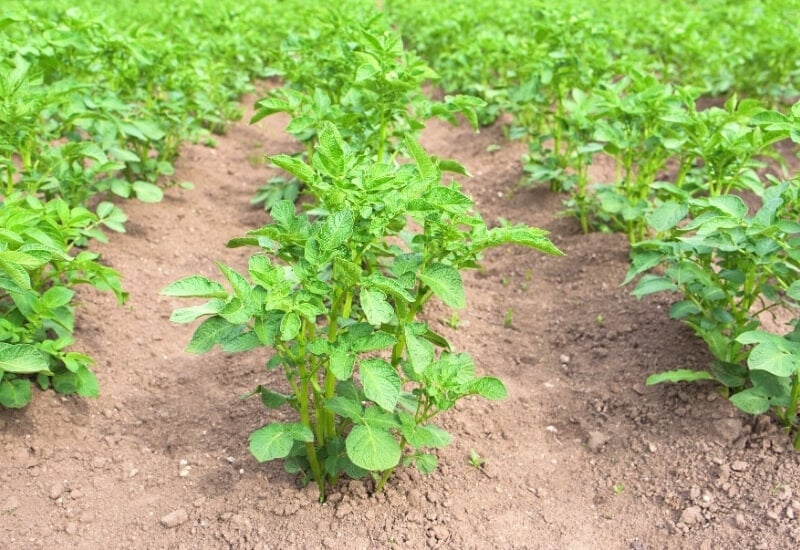
If you’re planting according to the square foot gardening method, space potatoes evenly across a plot no more than 4’ wide.
If you’re planting potatoes in rows, calculate total row length and divide it into as many rows as you need to fit into your garden space. Space rows 2’ – 3’ apart for easy harvesting.
For some quick averages, use the following guidelines:
2lbs of seed potatoes will plant 20’ of row length.
2lbs of seed potatoes will yield 20lbs of mature potatoes.
These numbers are calculated using the average potato grown in average conditions. Potatoes grown in loose, rich, fertile soil, and covered with mounds of soil or mulch during the growing season will yield more tubers.
How to Choose a Seed Potato Variety
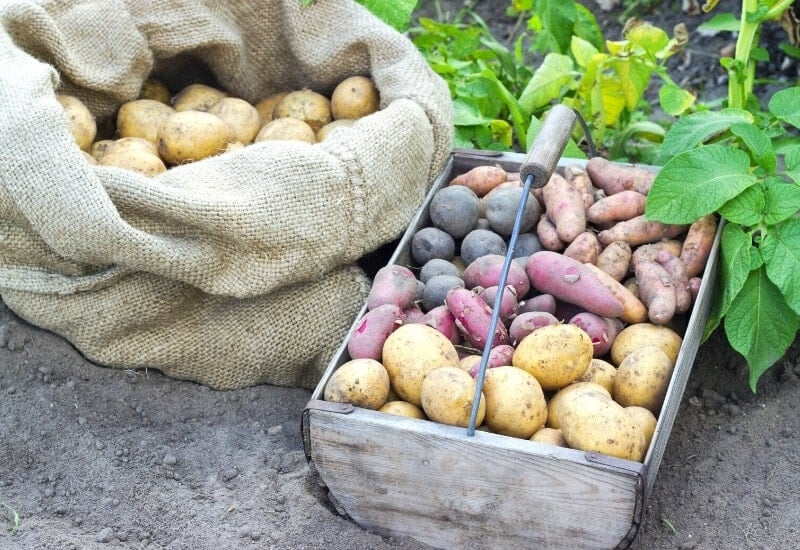
Now that you’ve done some fun calculations, it’s time to filter through 200+ potato varieties to decide which ones to plant in your garden.
Don’t worry, though, we’re going to break down the most common options.
Potatoes are broken down into categories based on how well they hold up to different cooking methods. For most home growers, a good all-purpose potato is satisfactory for basic household dishes.
However, if you’re selling potatoes or you have a specific processing method you want to use, it’s worth being a bit more choosy over your variety.
Starchy Potatoes
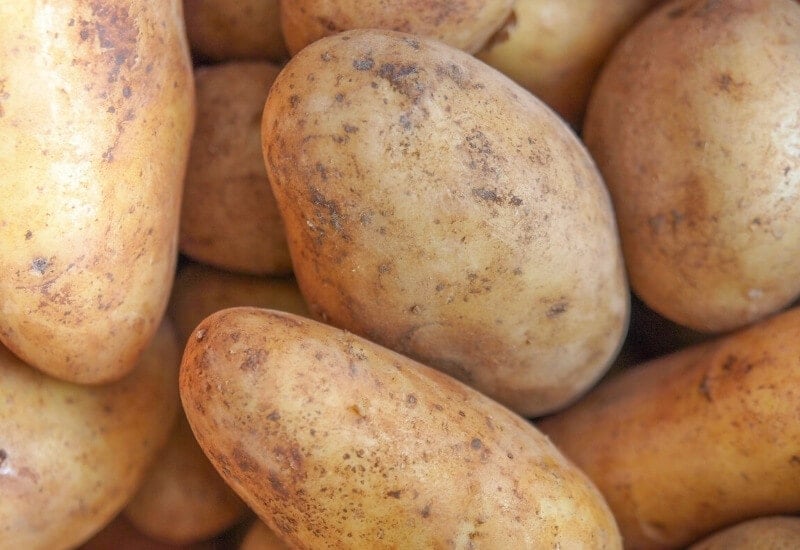
These potatoes are a good all-purpose potato because they are absorbent. Starchy potatoes are easy to mash but also easy to fry.
Popular types of starchy potatoes include Russet, Gold Rush, and Idaho potatoes.
Waxy Potatoes
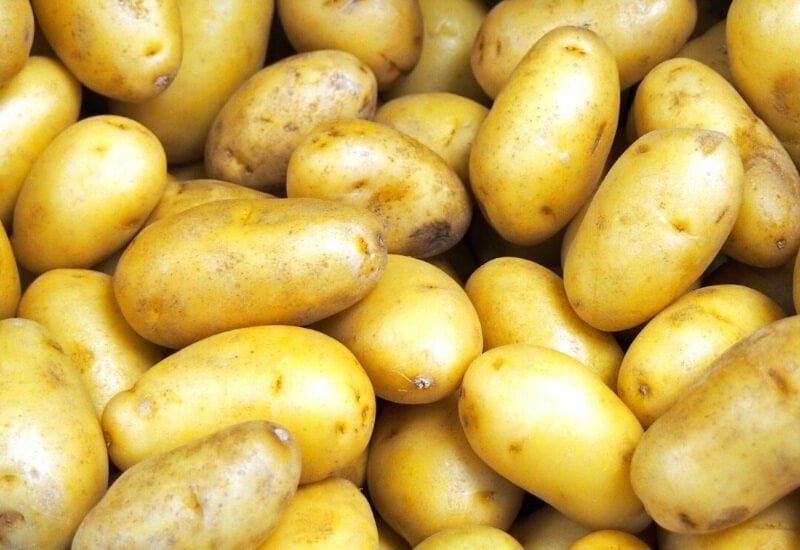
These are potatoes with thin skin and firm flesh. Waxy potatoes hold their shape when cooking, which makes them perfect for potato salad, soup, and grilling.
Popular types of waxy potatoes include Red, Purple, and Fingerling potatoes.
All-Purpose Potatoes
All-purpose potatoes are self-explanatory; they can be used for anything but they don’t excel at anything. These potatoes can be mashed, baked, fried, or boiled with relative success.
The most popular all-purpose potato is Yukon Gold.
Popular Varieties
There are many gold-standard potato varieties, but do some research on what grows well in your climate zone before you order anything online. Ideally, order from local growers who select their stock to do well in your specific climate.
Yukon Gold
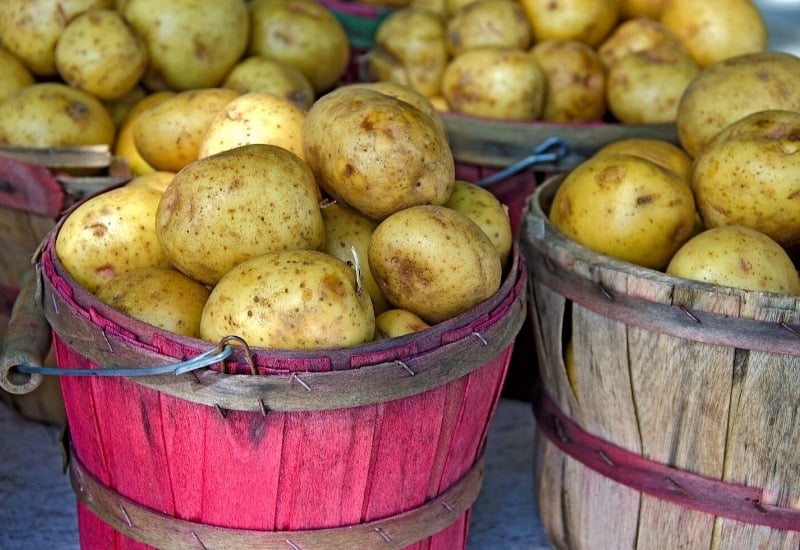
The all-star, all-purpose, average potato. Yukon Gold potatoes are an early variety, which makes them a good choice for northern climates. They are also notorious for pest and disease resistance.
White Rose
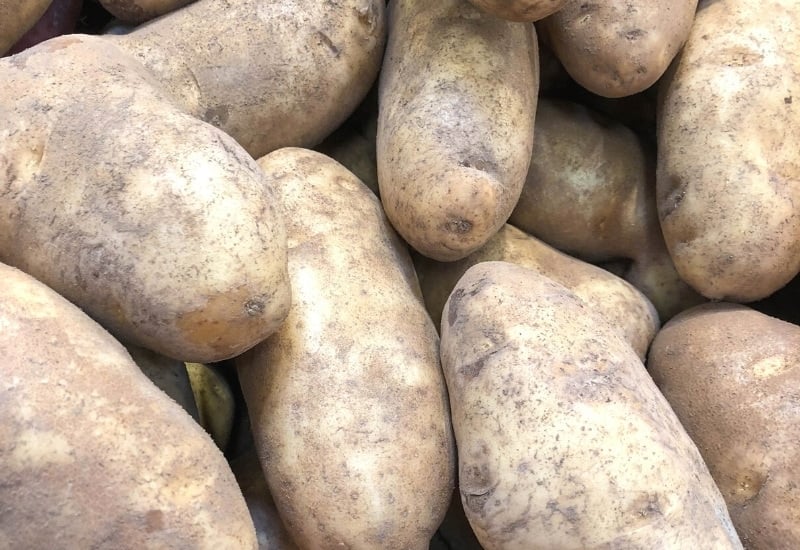
This is a popular waxy variety with a firm, white flesh. White Rose is an early variety.
Kennebec/Idaho
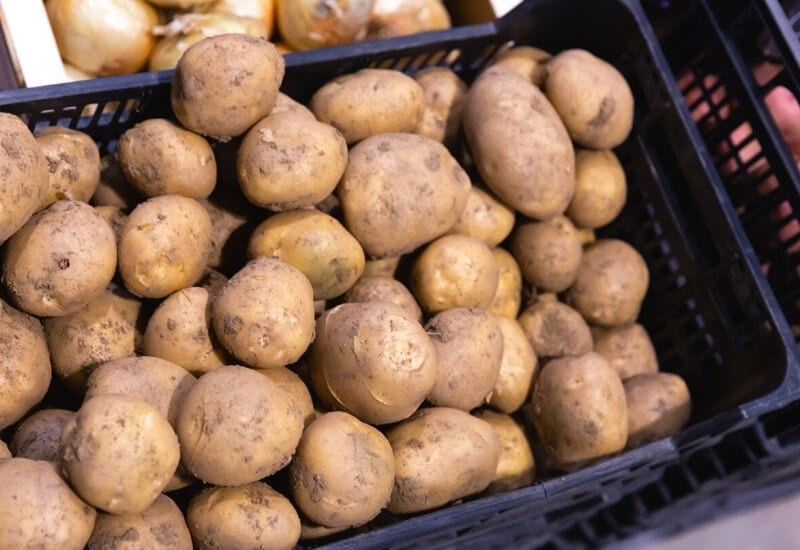
This is a late-maturing, starchy potato with high yields and excellent pest resistance. Idaho potatoes have an excellent shelf life.
Red Pontiac
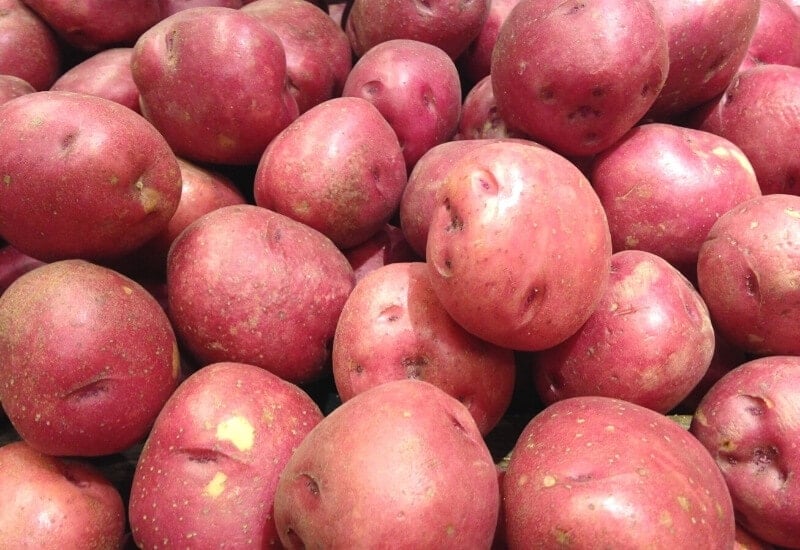
This waxy variety is average in the kitchen, but shines in the cellar. Red Pontiac stores well and has a beautiful, red skin.
All Blue
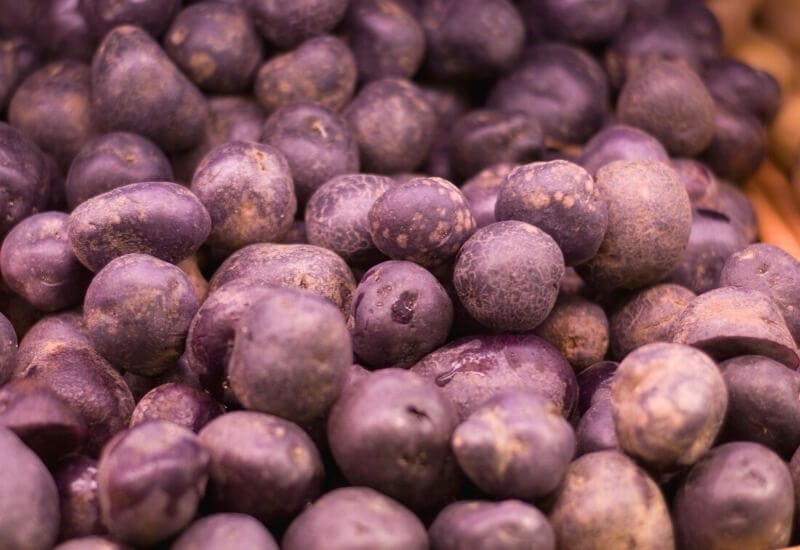
This waxy potato has a deep, rich flavor and color. Colorful potatoes are similar in nutrition to other potatoes, but they are substantially higher in antioxidants. Blue potatoes are a late season variety.
Norgold Russet
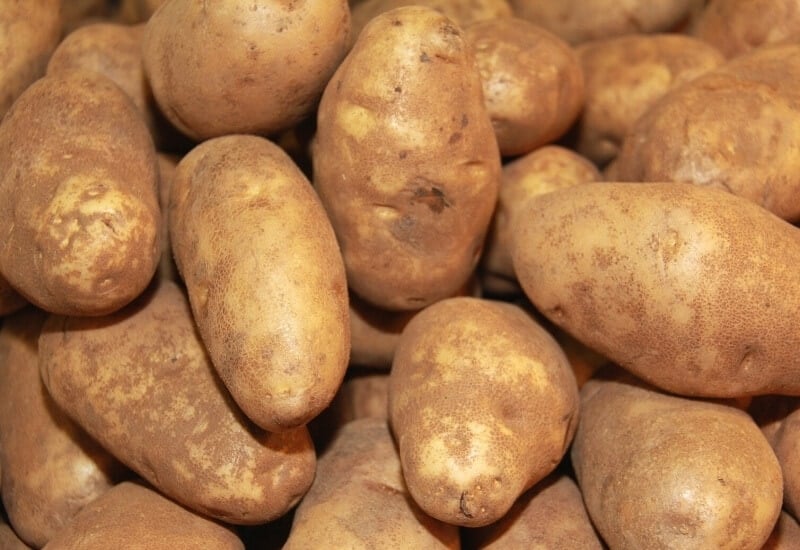
These are a good all-purpose starchy potato with a yellow/gold flesh. Russets are an early variety with a strong shelf life.
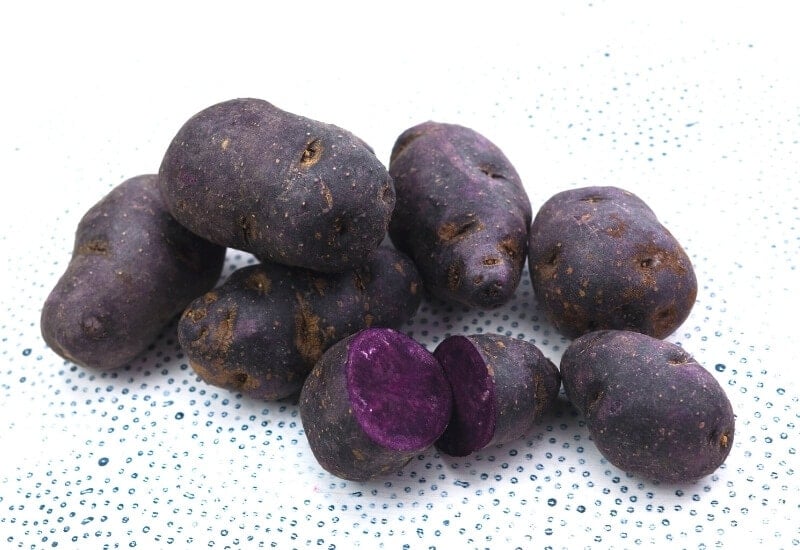
Purple Viking
These are all-purpose tubers that are superior to Yukon Gold in every way. According to official taste testers (yep, real thing), Purple Viking potatoes are more flavorful and have a better texture than Yukon Gold, plus they look better.
Purple Majesty
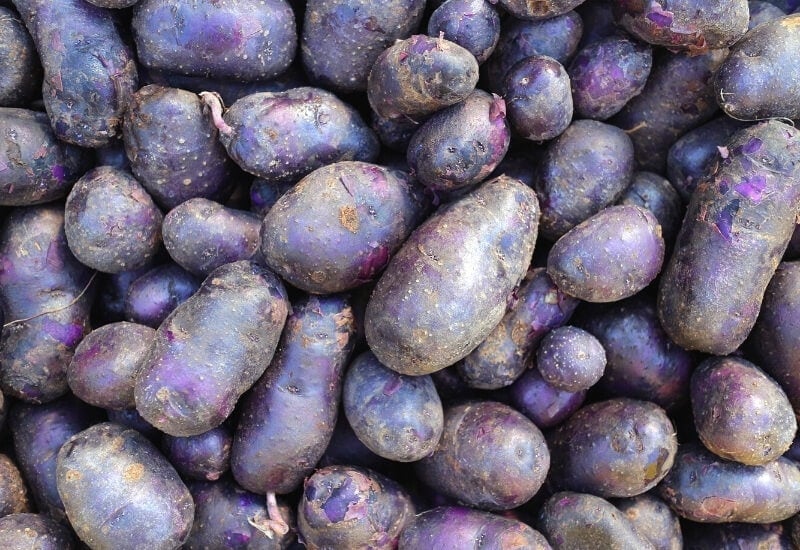
Purple Majesty potatoes have a beautiful, deep purple flesh. They are grown commercially in South America, but they are becoming popular in home gardens. Purple Majesty potatoes don’t store well, but they can sell for over $2/pound, making them a lucrative variety for hobby farmers.
Where to Buy Seed Potatoes?
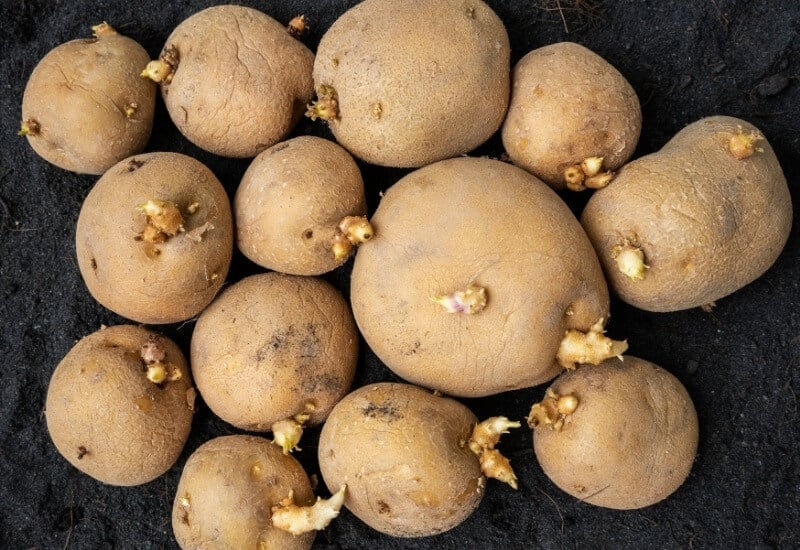
Potatoes are prone to pests, diseases, and soil-borne pathogens. It’s important to get your seed potatoes from a certified grower, or else you may be bringing infected plants into your garden, and this could ruin your soil for potatoes for years.
Any certified seed potatoes are safe to grow in your garden. Organically-grown seed potatoes may have come in contact with fewer chemicals, but they are no more disease-free than any other certified seed potato.
Plant store-bought potatoes at your own risk. Many people have successfully grown potatoes from store-bought tubers, but there are two major risks with this approach:
If you do decide to grow store-bought potatoes, make sure you don’t use any with brown spots in the flesh to avoid introducing blight to your potato crops.
How to Prepare Soil to Plant Seed Potatoes
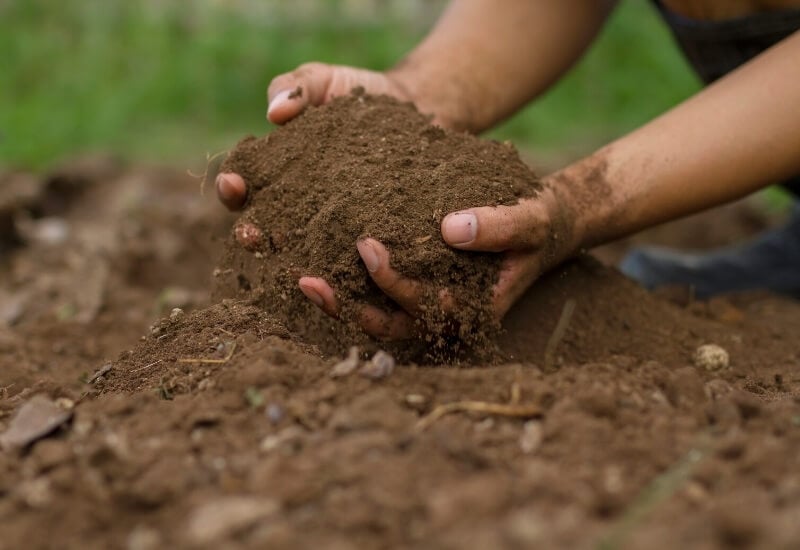
This final and crucial step of preparing to plant seed potatoes can determine yield, pest resistance, disease resistance, shelf life, and even flavor.
Potatoes need loose, rich, well-drained soil without rocks or debris that can harm the skin. Depending on how you intend to grow potatoes, you may also need excess soil to build up hills around the stems to increase yield.
Nutrients Potatoes Use During Each Growth Cycle
Potatoes are heavy feeders, so soil preparation must include amending with compost each year you plant potatoes.
You should always do a soil test before you add specific amendments to your soil, like chelated iron or lime. However, you can add as much compost as you want to a garden plot as long as it has matured properly.
Nutrients Potatoes Use During Early Growth
When the seed potato sprouts, it will use the nutrients within the potato to sustain initial stem and root formation. As soon as the roots are able to absorb water, the potato plant will start using nutrients from the surrounding soil to form top growth.
Nutrients Potatoes Use During Hooking & Tuber Initiation
The hook stage is when the potato plant initiates the tuber initiation phase. Basically, hooking is what prepares the plant to start forming tubers.
Nutrients Potatoes Use During Tuber Maturation
Once the plant begins to bloom, the plant will transition from initiating tubers into adding bulk to existing tubers. This phase is important because it will thicken the skin and prepare tubers for storage.
How PH Values Affect Nutrients During Potato Formation
Most plants prefer a pH of 6 – 6.5, which is the sweet spot for the six major nutrients (nitrogen, phosphorus, potassium, sulphur, calcium, magnesium). As pH becomes more acidic or alkaline, the soil either binds or frees nutrients to make them more or less available to plants.
Potatoes prefer a pH of 5.3 – 6, which is much more acidic than most vegetables. This is the range where iron, boron, zinc, and manganese are available in the highest concentrations, which are the nutrients responsible for pest and disease resistance, along with improving skin quality.
If potatoes are grown in more alkaline soils, or anything over 6.5, these nutrients are less available, and the overall quality of the potato will decrease.
Even if you use amendments high in trace nutrients, they will only be available within a certain pH range, so test your soil each year and try to adjust pH before you apply nutrient-specific amendments.
How to Amend Soil with Compost to Grow Seed Potatoes
Potatoes are a nutrient-dense, starchy vegetable, which means they use a lot of nutrients during development. In fact, potatoes are such heavy feeders that many growers plant them directly into a bag of compost.
The rule of thumb for using compost in a potato plot is to add as much as you can, and try to mix it in without overworking the soil.
The only way you can harm potatoes with compost is if you add compost that is too green, which may cause tubers to rot. Immature compost produces heat when you add it into the soil, and these pockets of decomposing organic material may harm developing potatoes. This is more likely with manure-based compost products than plant-based compost products.
How To Amend Soil With Compost
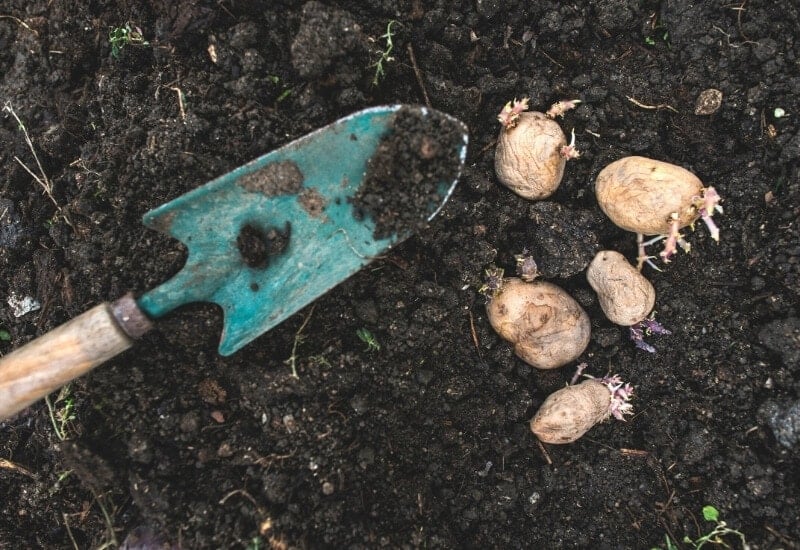
Ideally, you should prepare a potato plot during the fall so it is ready to go the following spring. Potatoes can be planted as soon as the ground thaws, but if you wait to add compost until the spring, you may have to postpone planting until the ground is able to be tilled so you can mix in compost before planting.
Only till soil when it is moist. If the soil is wet enough to drip water, it will form large clumps after tilling. If the soil is too dry, it will break down and compact after irrigation.
This method ensures compost will not harm new tubers, and it also prepares a weed-free plot that will be ready to plant as soon as the soil thaws.
If you wait until spring to prepare the soil, you can use the same method as above, except you must wait until the soil has thawed enough to be tilled without destroying the structure.
Do You Have To Chit Seed Potatoes Before Planting?
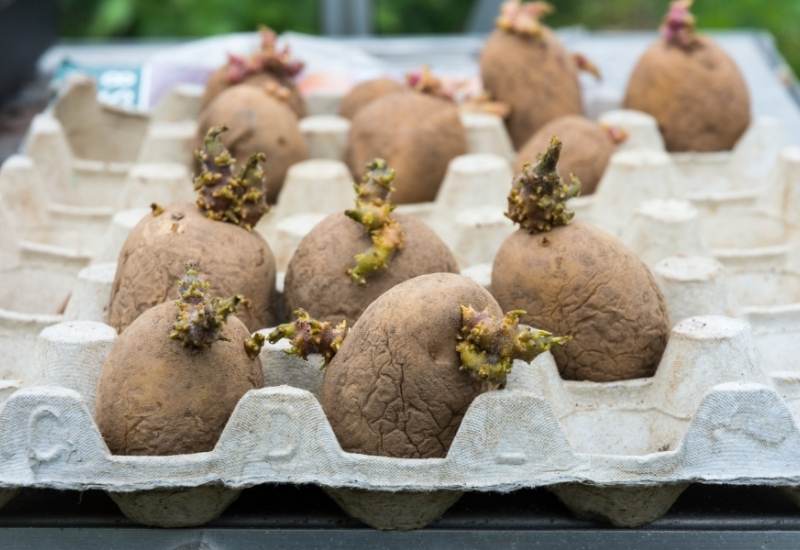
Chitting is a common, but completely optional, first step in the seed potato planting process.
Have you ever left a bag of potatoes in the cabinet for so long that they begin to sprout? If so, you’re already familiar with chitting.
Starting in January, leave seed potatoes in a cool, sunny spot with a little moisture, like in a tray with a damp towel. Place the seed potatoes so the majority of the eyes are facing the light.
After a few weeks, you should notice small, green nodes forming on the eyes. These will eventually sprout and produce long, leafy green stems. Keep potatoes moist until you plant them outside.
You don’t have to chit seed potatoes, but they will give you a head start on the growing season. This is especially beneficial in cooler climates with a shorter growing season.
Chitting also reduces the risk of rot when you plant seed potatoes, which is common when potatoes are planted in cool, wet weather.
Another common practice with chitting is cutting the seed potato to get more plants. If you can cut potato chunks with 2-3 eyes per piece, you can increase the amount of plants you get per pound of seed potatoes.
The risk with cutting potatoes is rot. But, if you chit potatoes after cutting, you can reduce this risk exponentially.
So, the rule of thumb is if you want to cut your seed potatoes, you should chit them.
Otherwise, it’s a matter of timing and preference.
How to Plant Seed Potatoes
There are a few different ways to plant seed potatoes, but the most common is to plant them directly into the soil. You can plant potatoes in containers or raised beds, but this may reduce yields.
No matter how you decide to grow potatoes, always rotate garden beds and/or discard used soil. Potatoes are prone to soil-borne viruses, and planting potatoes in the same soil year after year can encourage a buildup of pathogens that can destroy future crops.
How To Plant Seed Potatoes In Rows
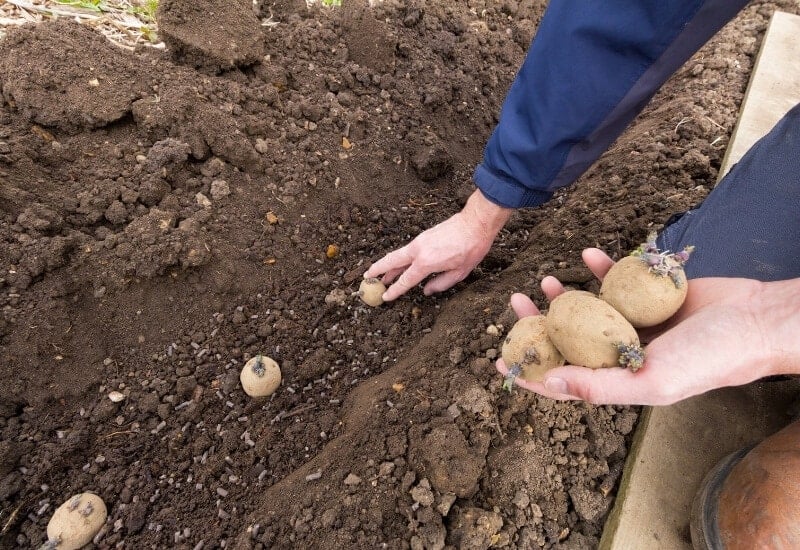
Planting in seed potatoes in rows is the easiest way to grow them. As tubers develop, you will have to pile soil up around the stems of the plant, which is easiest to do if you have wide rows with plenty of walking space.
Space rows 2’ – 3’ apart to allow for easy maintenance and a clear pathway for moving soil in wheelbarrows.
Remember: potatoes need loose soil, so avoid stepping near the plants. Use the center of the pathway as much as possible.
You have two options for growing in rows:
If you plant potatoes even with the soil, you will have to bring in some type of soil or mulch to cover the stems as they grow. Stems, not roots, produce tubers, so the more soil you pile around the stems, the more tubers you will get.
If you plant potatoes in a trench, you can fill in the trench as the potatoes grow. The added benefit to trench planting is that the potatoes can spread out as deep and wide as they want as the trench is filled in, whereas piling soil onto the stem above the ground provides a smaller area for tubers to develop.
Either way, the planting process is simple.
If You Want To Plant Seed Potatoes Even With The Ground:
As the plant grows, pile soil or straw mulch around the stem to cover all but the top leaves. Continue to mound soil around the plant until it begins to bloom.
If You Want To Plant Seed Potatoes In A Trench:
As the potatoes grow, fill in the trench. Continue to pile soil around the stem until the plant begins to bloom.
How To Plant Seed Potatoes In Plots
This is similar to planting potatoes in rows, but the spacing is different.
If you want large, mature potatoes, space the plants 12” apart in all directions. If you want smaller, new potatoes, space the plants 6” – 10” apart in all directions.
Avoid stepping in the plot as much as possible to maintain a crumbly, loose soil structure. Plots should be no more than 4’ wide unless you place stepping stones or planks of wood in the plot to step on as you tend to the plants.
How To Plant Seed Potatoes In Containers
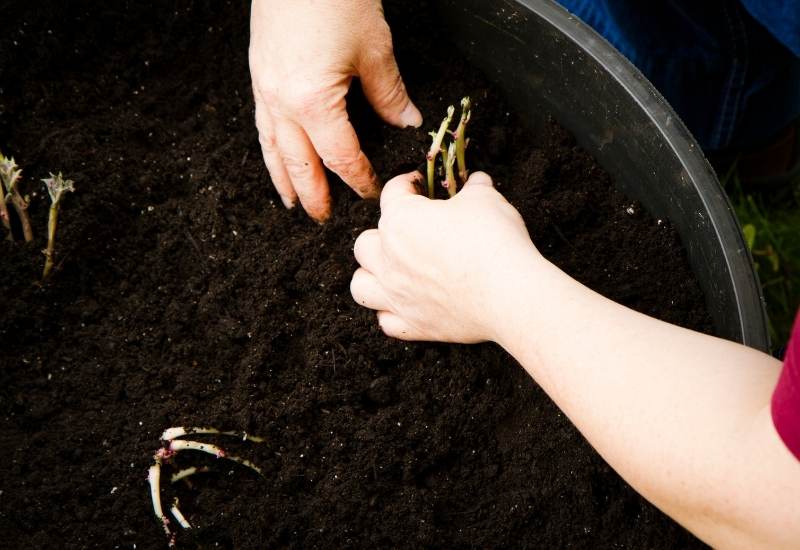
Container growing makes the harvesting process much easier; just dump out the soil and pull out the potatoes. However, tubers tend to be smaller, so container growing is best for new potatoes.
Make sure containers are large enough to support proper tuber development. A 5-gallon bucket is the smallest container you should use for potatoes.
You may also incorporate a few potato plants into raised beds or large garden containers. Potatoes will need a few feet of soil depth and they can add considerable weight to a container, so make sure your bed or box is large and sturdy enough to support mature potato plants.
If you do decide to plant potatoes in a container with other plants, consider how the harvesting process will affect other flowers and vegetables.
Plant fast-maturing vegetables like radishes or carrots near potato plants so you can dig them all up at the same time without harming nearby root systems of more established plants.
To Plant Seed Potatoes In Single Containers:
Use deep, wide containers for the best yields.
To Plant Seed Potatoes In Raised Beds:
Containers tend to have looser soil than in-ground plots or rows, so you can space potatoes a little closer in raised beds. Yields may be lower in raised beds because it is difficult to mound soil around the stems.
How To Plant Seed Potatoes In Bags Of Compost
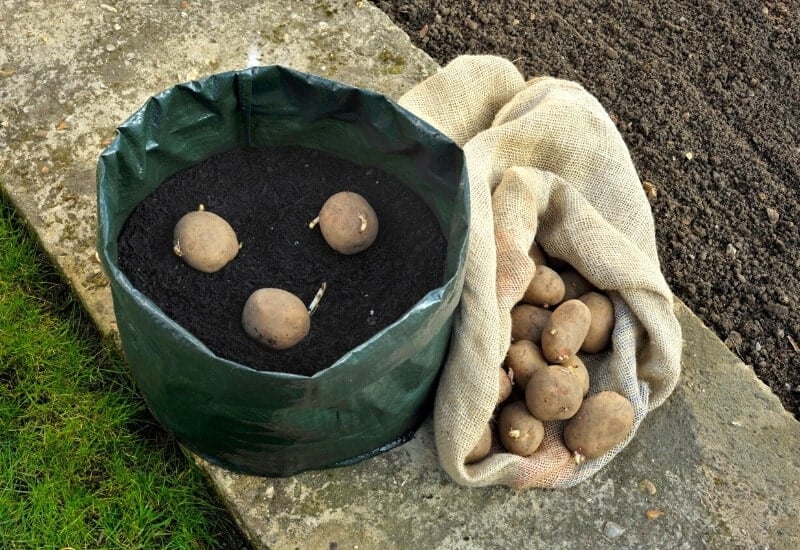
Remember when we said potatoes are heavy feeders? Well, one sure-fire method of giving them plenty of nutrients is to plant them straight into a bag or pile of compost.
However, this is not without some risks:
Generally speaking, these risks are minimal, and most gardeners have great success with growing potatoes in bags or piles of compost.
To Plant Potatoes In Bags Of Compost:
Bags hold more moisture than containers, so water lightly until the plants are actively growing to prevent the tubers from rotting.
To Plant Potatoes In A Pile Of Compost:
You may have to add a small support to the compost as the tubers develop to prevent the compost from washing away.
No matter how to decide to plant your potatoes, keep them watered, mulched, and weeded. When the plants bloom and the tops start to die back, pull away the soil and start harvesting.
Potatoes are fun to grow and even more fun to harvest, which makes the planning and preparation worth the effort. Find unique and colorful varieties to enjoy flavorful, nutritious meals straight from your garden.
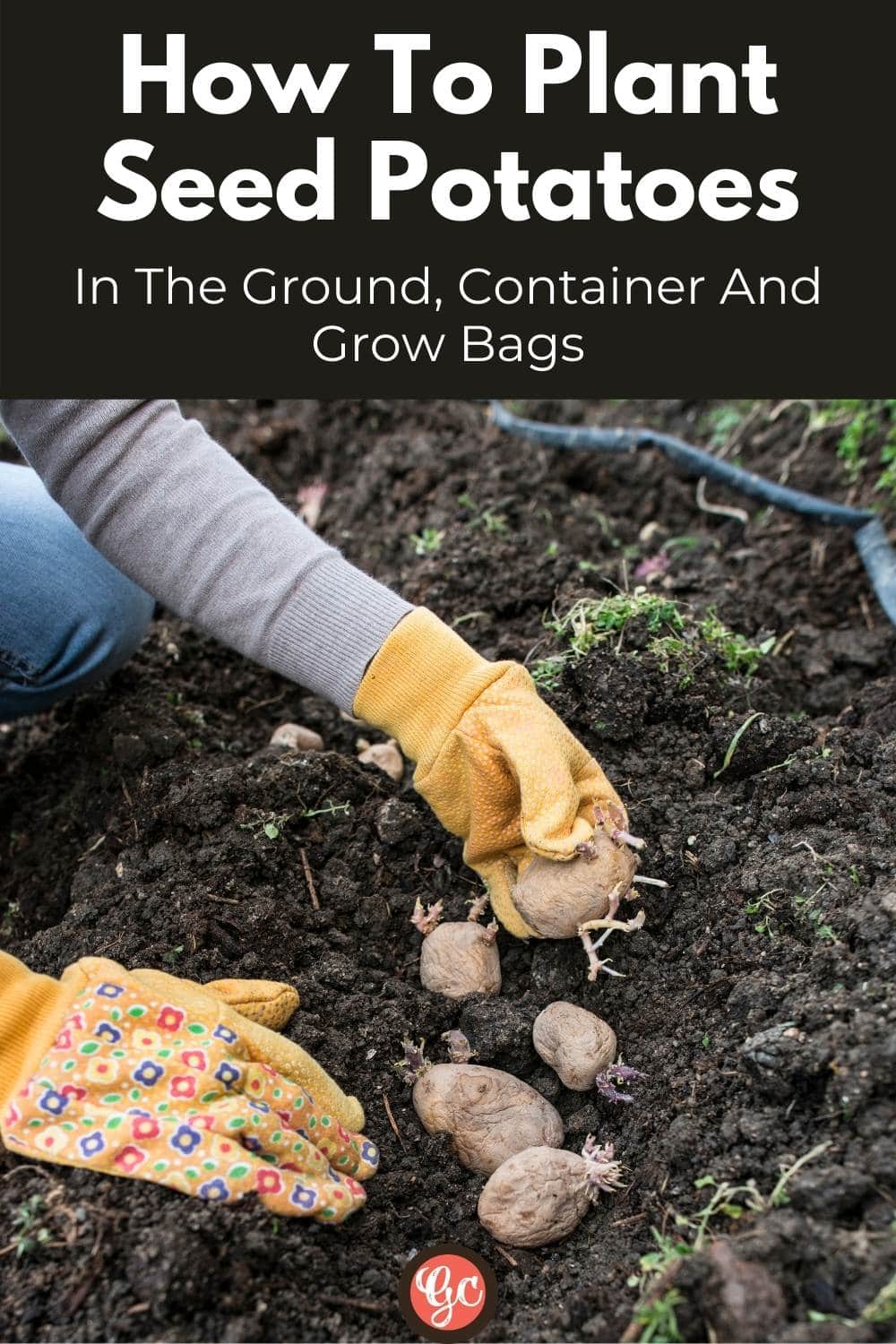

Written By
Amber Noyes
Amber Noyes was born and raised in a suburban California town, San Mateo. She holds a master’s degree in horticulture from the University of California as well as a BS in Biology from the University of San Francisco. With experience working on an organic farm, water conservation research, farmers’ markets, and plant nursery, she understands what makes plants thrive and how we can better understand the connection between microclimate and plant health. When she’s not on the land, Amber loves informing people of new ideas/things related to gardening, especially organic gardening, houseplants, and growing plants in a small space.
